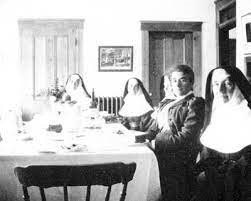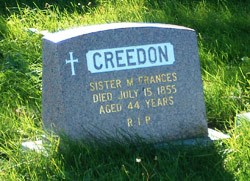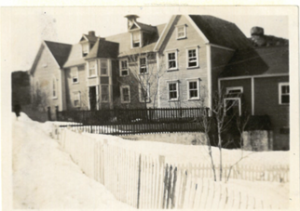Maria Nugent had the unique distinction of being the first Presentation postulant and the first Mercy postulant in Newfoundland and consequently in North America.

Known to us as Sister Mary Joseph, Maria died on this day in 1847, just five years after the founding of the Mercy mission in Newfoundland. Maria lived with her brother, Valentine Nugent and his family who had come to St. John’s from Ireland in 1833 at the invitation of Bishop Fleming.
Marianne Creedon, whose sister was Nugent’s wife, lived in the same household until she left for Ireland in 1839. For a number of years Maria and Marianne taught together at a school for young ladies on Water Street.
In 1834 Maria was admitted to the novitiate of the Presentation Sisters at Cathedral Square but later returned home because of ill health. Shortly after Marianne, now Sister Mary Francis, and her two companions came to St. John’s to begin their mission, Maria asked to join them. Bishop Fleming deemed her Presentation novitiate as fulfilling the requirements for entrance to the Mercy Order and she was professed as Sister Mary Joseph on March 25, 1843 in a ceremony held at the Presentation Convent.
Sister M. Joseph taught in the first Mercy school and was Sister M. Francis’ only companion when Sisters Ursula and Rose returned home in November of 1843. The two women, connected by bonds of family and love for the mission, faithfully carried out the responsibilities of school and visitation day after day in all kinds of weathers. An article in The Newfoundlander on June 24, 1847 gives a sense of their devotion and commitment:
Ever and anon might these two pious Sisters have been seen,
before or after the toils of the day at school, treading through
our snows and pelted by our sleet to smooth the pillow of the
death-bed of the afflicted, and pouring into the ear of the
infected words of promise and hope, either in the wretched
hovels of the poor or in the hospital.
In June of 1847 when a typhus epidemic broke out in St. John’s, Sisters M. Francis and M. Joseph closed school and devoted themselves totally to those afflicted with the dreaded disease, visiting and caring for them in their homes and at St. John’s Hospital, located in present-day Victoria Park area. It was while Sister M. Joseph was caring for a young seaman who was dying from typhus that she herself became infected. After two weeks of intense suffering, she died on June 17 at the age of 48. She is buried with other victims of the disease on land which is now occupied by the Kirk.
We are the proud and grateful inheritors of this wonderful tradition of trust in God’s Providence, compassionate care and faithful service.
- Read more Sisters stories documenting our Newfoundland Mercy Story
Maria Nugent tuvo la distinción única de ser la primera postulante de la Presentación y la primera postulante de la Misericordia en Terranova y, por consiguiente, en América del Norte.

Conocida por nosotros como la Hermana Mary Joseph, María murió un día como hoy en 1847, sólo cinco años después de la fundación de la misión de la Misericordia en Terranova. María vivía con su hermano, Valentine Nugent y su familia, que habían llegado a San Juan desde Irlanda en 1833 invitados por el obispo Fleming.
Marianne Creedon, cuya hermana era la esposa de Nugent, vivió en la misma casa hasta que se marchó a Irlanda en 1839. Durante varios años Maria y Marianne enseñaron juntas en una escuela para señoritas en Water Street.
En 1834, María ingresó en el noviciado de las Hermanas de la Presentación en Cathedral Square, pero más tarde regresó a casa por motivos de salud. Poco después de que Marianne, ahora hermana Mary Francis, y sus dos compañeras llegaran a St. John’s para comenzar su misión, María pidió unirse a ellas. El Obispo Fleming consideró que su noviciado en la Presentación cumplía los requisitos para entrar en la Orden de la Merced y profesó como Hermana Mary Joseph el 25 de marzo de 1843 en una ceremonia celebrada en el Convento de la Presentación.
La Hermana M. Joseph enseñó en la primera escuela de la Misericordia y fue la única compañera de la Hermana M. Francis cuando las Hermanas Ursula y Rose regresaron a casa en noviembre de 1843. Las dos mujeres, unidas por lazos de familia y amor a la misión, cumplieron fielmente con las responsabilidades de la escuela y la visitación día tras día en todo tipo de climas. Un artículo publicado en The Newfoundlander el 24 de junio de 1847 da una idea de su devoción y compromiso:
Estas dos piadosas hermanas han sido vistas una y otra vez,
antes o después de los trabajos del día en la escuela, atravesando
nuestras nieves y aguanieve para alisar la almohada del lecho de muerte de los afligidos.
lecho de muerte de los afligidos, y vertiendo en el oído de los
infectados palabras de promesa y esperanza, ya sea en las míseras
de los pobres o en el hospital.
En junio de 1847, cuando estalló una epidemia de tifus en St. John’s, las hermanas M. Francis y M. Joseph cerraron la escuela y se dedicaron por completo a los afectados por la temida enfermedad, visitándolos y cuidándolos en sus casas y en el hospital de St. John’s, situado en la actual zona de Victoria Park. Fue mientras la hermana M. Joseph cuidaba a un joven marinero que se estaba muriendo de tifus cuando ella misma se infectó. Tras dos semanas de intenso sufrimiento, murió el 17 de junio a la edad de 48 años. Está enterrada, junto con otras víctimas de la enfermedad, en el terreno que hoy ocupa el Kirk.
Somos los orgullosos y agradecidos herederos de esta maravillosa tradición de confianza en la Providencia de Dios, cuidado compasivo y servicio fiel.
- Lea más historias de Hermanas que documentan nuestra Historia de Misericordia de Terranova


 What must have been their thoughts as they looked upon the forbidding landscape with its towering rocky c liffs and craggy head lands ? Although they had seen poverty in Ireland, t he abject poverty of this place with its rude shacks and derelict fishing stages perched on the side of the hills, would have seared their hearts and minds. Sister Francis had lived in the colony for six years, but for Sisters Ursula and Rose the scene before them must have caused some dismay and distress.
What must have been their thoughts as they looked upon the forbidding landscape with its towering rocky c liffs and craggy head lands ? Although they had seen poverty in Ireland, t he abject poverty of this place with its rude shacks and derelict fishing stages perched on the side of the hills, would have seared their hearts and minds. Sister Francis had lived in the colony for six years, but for Sisters Ursula and Rose the scene before them must have caused some dismay and distress. ¿Qué debieron de pensar al contemplar el imponente paisaje de acantilados rocosos y escarpados promontorios? Aunque habían visto la pobreza en Irlanda, la abyecta pobreza de este lugar, con sus rudimentarias chozas y sus abandonadas etapas de pesca encaramadas en las laderas de las colinas, les habría abrasado el corazón y la mente. La hermana Francis había vivido en la colonia
¿Qué debieron de pensar al contemplar el imponente paisaje de acantilados rocosos y escarpados promontorios? Aunque habían visto la pobreza en Irlanda, la abyecta pobreza de este lugar, con sus rudimentarias chozas y sus abandonadas etapas de pesca encaramadas en las laderas de las colinas, les habría abrasado el corazón y la mente. La hermana Francis había vivido en la colonia
 By this time, the Sisters had been in Newfoundland for almost a year, a year in which they devoted themselves to the visitation and care of the poor and the sick of the town, traversing the narrow streets and visiting the rude shacks in which many of the Irish Catholics lived. Forty-two pupils were enrolled when the school opened, and in the following year fifty-five students were in attendance.
By this time, the Sisters had been in Newfoundland for almost a year, a year in which they devoted themselves to the visitation and care of the poor and the sick of the town, traversing the narrow streets and visiting the rude shacks in which many of the Irish Catholics lived. Forty-two pupils were enrolled when the school opened, and in the following year fifty-five students were in attendance. Upon arrival at Sandy Point, the sisters received an enthusiastic welcome from the people of Sandy point. The Evening Telegram of August 12, 1893 reported as follows:
Upon arrival at Sandy Point, the sisters received an enthusiastic welcome from the people of Sandy point. The Evening Telegram of August 12, 1893 reported as follows: She died at the age of 44, having been professed as a Sister of Mercy for fourteen years. A woman of great fortitude, zeal for mission and commitment to the ideals of Mercy instilled in her by Catherine McAuley, Francis gave her all to the Newfoundland mission.
She died at the age of 44, having been professed as a Sister of Mercy for fourteen years. A woman of great fortitude, zeal for mission and commitment to the ideals of Mercy instilled in her by Catherine McAuley, Francis gave her all to the Newfoundland mission. Persistent efforts by Burin’s zealous pastor, Father Michael Berney, for whom the education of the children of his parish was of prime importance, finally convinced Mother Xavier Bernard to make a positive response to his entreaties. St. Anne’s Convent (pictured at right) opened on July 12, 1863. The founding sisters were: Irish-born Sister M. Liguori Carmody; Sister M. Xavier Tarrahan, a Newfoundlander; Sister M. Charles McKenna, also Irish; Mary McAuliffe, a postulant.
Persistent efforts by Burin’s zealous pastor, Father Michael Berney, for whom the education of the children of his parish was of prime importance, finally convinced Mother Xavier Bernard to make a positive response to his entreaties. St. Anne’s Convent (pictured at right) opened on July 12, 1863. The founding sisters were: Irish-born Sister M. Liguori Carmody; Sister M. Xavier Tarrahan, a Newfoundlander; Sister M. Charles McKenna, also Irish; Mary McAuliffe, a postulant.